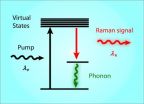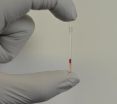(Press-News.org) Nanoparticles, engineered materials about a billionth of a meter in size, are around us every day. Although they are tiny, they can benefit human health, as in some innovative early cancer treatments, but they can also interfere with it through viruses, air pollution, traffic emissions, cosmetics, sunscreen and electronics.
A team of researchers at Washington University in St. Louis, led by Lan Yang, PhD, the Das Family Career Development Associate Professor in Electrical & Systems Engineering, and their collaborators at Tsinghua University in China have developed a new sensor that can detect and count nanoparticles, at sizes as small as 10 nanometers, one at a time. The researchers say the sensor could potentially detect much smaller particles, viruses and small molecules.
The research appears in the Proceedings of the National Academy of Sciences online Early Edition Sept. 1, 2014.
Yang and her colleagues have created the Raman microlaser sensor in a silicon dioxide chip to find individual nanoparticles without the need to "dope" the chip with chemicals called rare-earth ions to provide optical gain for the microlaser. Incorporating additions to the microresonator creates the need for more processing steps and increased costs and invites biocompatibility risks. In addition, the use of rare-earth ions requires specific "pump" lasers matching the energy transitions of the ions to generate optical gain, so for different rare-earth ions, different pump lasers must be used. Using the Raman process loosens the requirement of specific wavelength bands for pump lasers because Raman gain can be obtained using pump at any wavelength band, Yang says.
"This gives us the advantage of using the same dopant-free sensor at different sensing environments by tailoring the lasing frequency for the specific environment, for example, at the band where the environment has minimum absorption, and for the properties of the targeted nanoparticles by just changing the wavelength of the pump laser," says Sahin Kaya Ozdemir, PhD, a research scientist in Yang's group and the first author of the paper.
Yang's team integrated Raman lasing in a silica microcavity with the mode splitting technique pioneered by her group to develop a new, powerful sensor that more readily detects nanoparticles. The technology will benefit the electronics, acoustics, biomedical, plasmonics, security and metamaterials fields.
Yang's microsensor is in a class called whispering gallery mode resonators (WGMRs) because it works similarly to the renowned whispering gallery in London's St. Paul's Cathedral, where a person on one side of the dome can hear a message spoken to the wall by another person on the other side. Yang's device does much the same thing with light frequencies rather than audible ones.
One of the main differences between early resonators and the novel resonator, known as a morphology dependent resonator, was they didn't use mirrors to reflect light. Yang's WGMR is an actual mini-laser that supports "frequency degenerate modes," patterns of excitation inside the mini-laser's doughnut-shaped ring that are of the same frequency. One portion of light beamed by the Raman laser goes counterclockwise, another goes clockwise. When a particle lands on the ring and scatters energy between these modes, the single Raman lasing line splits into two lasing lines with different frequencies.
When a Raman laser beam is generated in the resonator, it likely will encounter a particle, such as a virus nanoparticle, on the circle. When the beam initially sees the particle, the beam splits into two, generating two lasing lines that serve as reference to the other to form a self-referenced sensing technique.
"Our new sensor differs from the earlier whispering gallery sensors in that it relies on Raman gain, which is inherent in silica, thereby eliminating the need for doping the microcavity with gain media, such as rare-earth ions or optical dyes, to boost detection capability," Ozdemir says. "This new sensor retains the biocompatibility of silica and could find widespread use for sensing in biological media."
"It doesn't matter what kind of wavelength is used, once you have the Raman laser circulating inside and there is a molecule sitting on the circle, when the beam sees the particle it will scatter in all kinds of directions," Yang says. "Initially you have a counterclockwise mode, then a clockwise mode, and by analyzing the characterization of the two split modes, we confirm the detection of nanoparticles."
In addition to the demonstration of Raman microlasers for particle sensing, the team says their work shows the possibility of using intrinsic gain mechanisms, such as Raman and parametric gain, instead of optical dyes, rare-earth ions or quantum dots, for loss compensation in optical and plasmonic systems where dissipation hinders progress and limits applications.
INFORMATION:
Ozdemir S, Zhu J, Yan X, Peng B, Yilmaz H, He L, Monifi F, Huang S, Long G, Yang L. Highly sensitive detection of nanoparticles with a self-referenced and self-heterodyned whispering-gallery Raman microlaser. Proceedings of the National Academy of Sciences, online Early Edition, Sept. 1, 2014.
Funding for this research was provided by the National Science Foundation and the U.S. Army Research Office.
The School of Engineering & Applied Science at Washington University in St. Louis focuses intellectual efforts through a new convergence paradigm and builds on strengths, particularly as applied to medicine and health, energy and environment, entrepreneurship and security. With 91 tenured/tenure-track and 40 additional full-time faculty, 1,300 undergraduate students, 750 graduate students and more than 23,000 alumni, we are working to leverage our partnerships with academic and industry partners — across disciplines and across the world — to contribute to solving the greatest global challenges of the 21st century.
Engineers develop new sensor to detect tiny individual nanoparticles
2014-09-01
ELSE PRESS RELEASES FROM THIS DATE:
Sierra Nevada freshwater runoff could drop 26 percent by 2100, UC study finds
2014-09-01
Irvine, Calif. — Freshwater runoff from the Sierra Nevada may decrease by as much as one-quarter by 2100 due to climate warming on the high slopes, according to scientists at UC Irvine and UC Merced.
Accelerated plant growth at higher elevations caused by increasing temperatures would trigger more water absorption and evaporation, accounting for the projected runoff declines, the researchers add.
A diminished river flow will only add to the burden of providing resources to the thirsty farms and homes that rely on it. The state is currently experiencing a severe drought, ...
Nature's tiny engineers
2014-09-01
CAMBRIDGE, Mass-- Conventional wisdom has long held that corals — whose calcium-carbonate skeletons form the foundation of coral reefs — are passive organisms that rely entirely on ocean currents to deliver dissolved substances, such as nutrients and oxygen. But now scientists at MIT and the Weizmann Institute of Science (WIS) in Israel have found that they are far from passive, engineering their environment to sweep water into turbulent patterns that greatly enhance their ability to exchange nutrients and dissolved gases with their environment.
"These microenvironmental ...
Location of body fat can increase hypertension risk
2014-09-01
WASHINGTON (Sept. 1, 2014) — People with fat around their abdominal area are at greater risk of developing hypertension when compared to those with similar body mass index but fat concentrations elsewhere on the body, according to a study published today in the Journal of the American College of Cardiology.
Obesity is a known risk factor for hypertension, or high blood pressure, and it is widely reported that the location of fat on a person's body can lead to increased risk of other health issues like heart disease and cancer. However, the relationship between hypertension ...
Ride-sharing could cut cabs' road time by 30 percent
2014-09-01
CAMBRIDGE, Mass-- Cellphone apps that find users car rides in real time are exploding in popularity: The car-service company Uber was recently valued at $18 billion, and even as it faces legal wrangles, a number of companies that provide similar services with licensed taxi cabs have sprung up.
What if the taxi-service app on your cellphone had a button on it that let you indicate that you were willing to share a ride with another passenger? How drastically could cab-sharing reduce traffic, fares, and carbon dioxide emissions?
Authoritatively answering that question ...
Faster, cheaper tests for sickle cell
2014-09-01
Within minutes after birth, every child in the U.S. undergoes a battery of tests designed to diagnose a host of conditions, including sickle cell disease. Thousands of children born in the developing world, however, aren't so lucky, meaning many suffer and die from the disease each year.
A.J. Kumar hopes to put a halt to at least some of those deaths.
A Post-Doctoral Fellow in Chemistry and Chemical Biology working in the lab of George Whitesides, the Woodford L. and Ann A. Flowers University Professor, Kumar and colleagues, including other co-authors, have developed ...
Training your brain to prefer healthy foods
2014-09-01
BOSTON (September 1, 2014, 10:20 AM EDT) — It may be possible to train the brain to prefer healthy low-calorie foods over unhealthy higher-calorie foods, according to new research by scientists at the Jean Mayer USDA Human Nutrition Research Center on Aging (USDA HNRCA) at Tufts University and at Massachusetts General Hospital. Published online today in the journal Nutrition & Diabetes, a brain scan study in adult men and women suggests that it is possible to reverse the addictive power of unhealthy food while also increasing preference for healthy foods.
"We don't start ...
Fruit consumption cuts CVD risk by up to 40 percent
2014-09-01
Barcelona, Spain – Monday 1 September 2014: Daily fruit consumption cuts the risk of cardiovascular disease (CVD) by up to 40%, according to research presented at ESC Congress today by Dr Huaidong Du from Oxford, UK. The findings from the seven year follow-up study of nearly 0.5 million people in the China Kadoorie Biobank found that the more fruit people ate, the more their risk of CVD declined.
Dr Du said: "CVD, including ischaemic heart disease (IHD) and stroke, is the leading cause of death worldwide. Improving diet and lifestyle is critical for CVD risk reduction ...
Permanent AF doubles risk of stroke compared to paroxysmal AF
2014-09-01
Barcelona, Spain – Monday 1 September 2014: Permanent atrial fibrillation (AF) doubles the risk of stroke compared to paroxysmal AF, according to research in more than 6 000 patients presented at ESC Congress today by Dr Thomas Vanassche from Belgium. The findings suggest that a simple clinical assessment of the type of AF can help doctors to better estimate stroke risk.
Ischaemic stroke is the second cause of death in the EU, accounting for over a million deaths and many more disabled patients each year. Annual direct health care costs amount to more than €20 billion. ...
A nucleotide change could initiate fragile X syndrome
2014-09-01
Researchers reveal how the alteration of a single nucleotide—the basic building block of DNA—could initiate fragile X syndrome, the most common inherited form of intellectual disability. The study appears in The Journal of Cell Biology.
Fragile X syndrome is caused by a defect in a gene on the X chromosome called fragile X mental retardation 1 (FMR1). Around 1 in 230 women and 1 in 360 men carry a so-called premutation, in which a series of DNA repeats at one end of the FMR1 gene is slightly longer than normal. These repeats are prone to even further expansion when ...
Scientists call for investigation of mysterious cloud-like collections in cells
2014-09-01
WASHINGTON — About 50 years ago, electron microscopy revealed the presence of tiny blob-like structures that form inside cells, move around and disappear. But scientists still don't know what they do — even though these shifting cloud-like collections of proteins are believed to be crucial to the life of a cell, and therefore could offer a new approach to disease treatment.
In the Journal of Cell Biology, two researchers are issuing a call to investigators from various backgrounds, from biophysics to cell biology, to focus their attention on the role of these formations— ...





